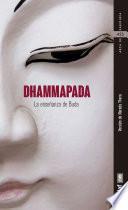
Busca tu libro....


The Dhammapada
Autor: Narada Thera
Número de Páginas: 88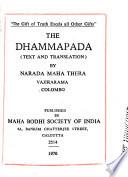
The Dhammapada
Autor: Nārada (maha Thera)
Número de Páginas: 402Buddhist canonical work.
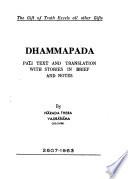
Dhammapada
Número de Páginas: 356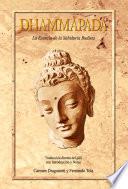
Dhammapada
Autor: Dra. Carmen Dragonetti
Número de Páginas: 421El Dhammapada, traducido por primera vez al español directamente del pāli por Carmen Dragonetti y publicado en edición bilingüe por la Universidad Nacional Mayor de San Marcos de Lima, Perú, es una colección de 423 estrofas, la mayoría de dos versos, tan apreciada en los países budistas como la Bhagavad-Gītā en el Hinduismo. No sólo es una fuente excepcional de conocimiento del Budismo, sino también una obra de extraordinario mérito literario y a la vez un tesoro de sabiduría universal. “Todo el que quiera llegar a comprender el alma interior del Budismo – ha escrito Hermann Oldenberg, el gran budólogo alemán – ha de volver al Dhammapada, la más hermosa de sus colecciones en verso.” La traducción de Carmen Dragonetti se distingue por su fidelidad al texto original, su claridad, su precisión en la interpretación del pensamiento de la obra y la fluidez y sencillez del estilo. Está precedida por una introducción que estudia en forma detallada y lúcida los principales conceptos del Budismo, y acompañada de notas que aclaran el contenido de los versos, permitiendo una cabal comprensión de los mismos. La introducción y las notas constituyen un medio de...

The Dhammapada Or The Way of Truth
Número de Páginas: 51
The Dhammapada
Autor: M. T. Narada
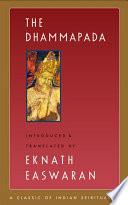
The Dhammapada
Autor: Eknath Easwaran
Número de Páginas: 283Dhammapada means "the path of dharma," the path of harmony and righteousness that anyone can follow to reach the highest good. Easwaran's translation of this classic Buddhist text is based on the oldest, best-known version in Pali. Easwaran's introduction to the Dhammapada gives an overview of the Buddha's teachings that is reliable, penetrating, and clear - accessible for readers new to Buddhism, but also with fresh insights and practical applications for readers familiar with this text. Chapter introductions place individual verses into the context of the broader Buddhist canon.

The Dhammapada
Autor: Narada (maha Thera.)
Número de Páginas: 359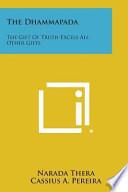
The Dhammapada
Autor: Narada Thera , Cassius A. Pereira
Número de Páginas: 116This is a new release of the original 1940 edition.
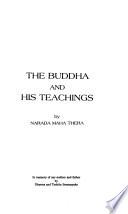
The Buddha and His Teachings
Autor: Nārada (maha Thera.)
Número de Páginas: 442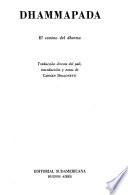
Dhammapada
Autor: Carmen Dragonetti
Número de Páginas: 266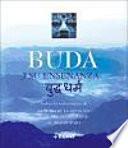
Buda y su enseñanza
Número de Páginas: 230Hace más de 2.500 años el príncipe Siddharta Gautama -Buda es un adjetivo que significa iluminado-, perteneciente al clan de los Shakyas en el norte de la India, dejó, a los veintinueve años, honores, familia y posesiones e inició la búsqueda de respuestas a unas preguntas que lo atormentaban: ¿Por qué sufre el ser humano? ¿Cuál es el verdadero origen del sufrimiento? Esa búsqueda desembocó en la experiencia cumbre de la iluminación liberadora y, a partir de ella, impartió una doctrina que nos ha llegado hasta hoy bajo el nombre de budismo. El budismo está tan vigente hoy como hace dos mil años y sus enseñanzas siguen iluminando y dando consuelo a millones de personas en todo el mundo. En esta obra el lector encontrará una breve semblanza biográfica de Buda, un análisis de su enseñanza y, sobre todo, los textos íntegros de las que están considerados las obras fundamentales del budismo: El Dhammapada, valorado por muchos como el texto ético más importante jamás escrito, y los Sutra de la Atención y Sutra del Diamante.
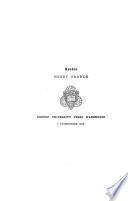
The Dhammapada
Autor: Friedrich Max Müller
Número de Páginas: 444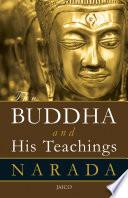
The Buddha and His Teachings
Autor: Narada
Número de Páginas: 534Description The Buddha was the first most active missionary in the world.He wandered from place to place for forty five years preaching His doctrine to the masses and the intellegentsia.Till His last moment,He served humaity both by example and by percept.His distinguished disciples followed suit.Penniless,they even travelled to distant lands to propogate the Dhamma,expecting nothing in return. This treatise,written by a member of the Order of the Sangha,is based on the pali Texts,commentaries,and traditions prevailing in Buddhist countries. The first part of the book deals with the Life of the Buddha,the second with the Dhamma,the Pali term for His Doctrine.
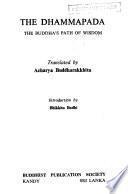
The Dhammapada
Número de Páginas: 120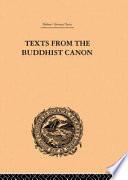
Texts from the Buddhist Canon
Número de Páginas: 196First Published in 2000. Routledge is an imprint of Taylor & Francis, an informa company.
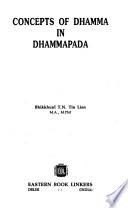
Concepts of Dhamma in Dhammapada
Autor: T. N. Tin Lien (bhikkhuni)
Número de Páginas: 168The Dhammapada Is The Most Popular And Best-Known Text Of The Pali Suttapitaka. It Is A Collection Of Chosen Verses Picked Up From Various Discourses Of Five Nikayas.
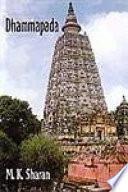
Dhammapada
Autor: M. K. Sharan
Número de Páginas: 254Philosophy, Cultural

The Dhammapada - The Buddha’s Path of Wisdom
Número de Páginas: 145"The Dhammapada - The Buddha’s Path of Wisdom" is an anthology of 423 verses spoken by the Buddha, the Dhammapada serves as the perfect compendium of his teachings for study, reflection, and contemplation. This popular publication, originally published by the Buddhist Publication Society in 1990, transmits the spirit and content as well as the style of the original, skillfully combining clarity and vigor of expression with careful fidelity to the meaning. The inclusion of the Pali text gives students of Pali immediate access to the original. A robust introduction by Bhikkhu Bodhi describes the structure of the Dhammapada and shows how the work embodies the essential teachings of the Buddha. He states, "Wherever [The Dhammapada] has become known its moral earnestness, realistic understanding of human life, aphoristic wisdom, and stirring message of a way to freedom from suffering has won for it the devotion and veneration of those responsive to the good and the true."
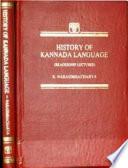
The Buddha-Dhamma, Or, the Life and Teachings of the Buddha
Autor: Ramanujapuram Narasimhacharya , Nārada (maha Thera.)
Número de Páginas: 366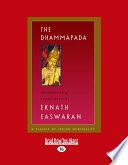
The Dhammapada (Large Print 16pt)
Autor: Eknath Easwaran
Número de Páginas: 266The Dhammapada: one of three new editions of the books in Eknath Easwaran's Classics of Indian Spirituality series ''As irrigators guide water to their fields, as archers aim arrows, as carpenters carve wood, the wise shape their lives.'' - Dhammapada (145).... Dhammapada means ''the path of dharma,'' the path of truth, harmony, and righteousness. Capturing the living words of the Buddha, this much-loved scripture consists of verses organized by theme: thought, joy, anger, pleasure, and others. The Dhammapada is permeated with the power and practicality of one of the world's most appealing spiritual teachers. Rejecting superstition on the one hand and philosophical speculation on the other, the Buddha taught the path to the end of suffering and showed how we can achieve lasting joy. He spells out our choices with a refreshing realism and frankness. And he insists that we be spiritually self-reliant: ''All the effort must be made by you. Buddhas only point the way.'' Easwaran believed that we need nothing more than the Dhammapada to follow the way of the Buddha. His main qualification for interpreting the Dhammapada, he said, was that he knew from his own experience that these...

Selection from Dhammapada
Autor: Piyadassi (thera.)
Número de Páginas: 88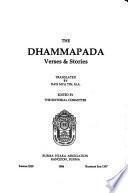
The Dhammapada, Verses and Stories
Número de Páginas: 652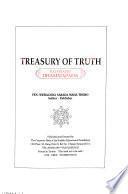
Treasury of Truth
Autor: Weragoda Sarada Maha Thero
Número de Páginas: 954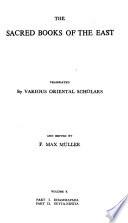
The Dhammapada
Número de Páginas: 408
Vivir abiertos de corazón
Autor: Steve Flowers , Bob Stahl
Número de Páginas: 212En Vivir abiertos de corazón descubriremos cómo el mindfulness y la compasión dirigida a uno mismo pueden liberarnos delos pensamientos y creencias que generan sentimientos de inadecuación. Aprenderemos a abrir nuestro corazón a la benevolencia interior y del mundo que nos rodea. Basado en la psicoterapia occidental y en los principios psicológicos budistas, este libro es una guía práctica para superar las creencias dolorosas y limitadoras que tenemos de nosotros mismos. Nos enseña a cultivar un tipo de consciencia que permite la aceptación de quienes somos. La práctica de la atención plena y la compasión pueden liberarnos de pensamientos improductivos y nos ayudarán a vivir con más libertad y menos miedo, con el corazón totalmente abierto.
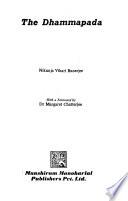
The Dhammapada
Autor: Nikunja Vihari Banerjee
Número de Páginas: 188Buddhist canonical work.

The Dhammapada
Autor: F. Max Muller
Número de Páginas: 48The Dhammapada (Pāli; Prakrit: धम्मपद Dhammapada;[1]) is a collection of sayings of the Buddha in verse form and one of the most widely read and best known Buddhist scriptures.[2] The original version of the Dhammapada is in the Khuddaka Nikaya, a division of the Pali Canon of Theravada Buddhism. The Buddhist scholar and commentator Buddhaghosa explains that each saying recorded in the collection was made on a different occasion in response to a unique situation that had arisen in the life of the Buddha and his monastic community. His commentary, the Dhammapada Atthakatha, presents the details of these events and is a rich source of legend for the life and times of the Buddha
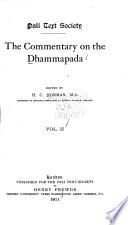
The Commentary on the Dhammapada
Autor: Dhammapadatṭḥakathā
Número de Páginas: 834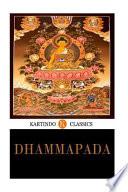
Dhammapada (Kartindo Classics)
Número de Páginas: 44The Dhammapada is a collection of sayings of the Buddha in verse form and one of the most widely read and best known Buddhist scriptures. The original version of the Dhammapada is in the Khuddaka Nikaya, a division of the Pali Canon of Theravada Buddhism.

The Dhammapada
Autor: Nārada (maha Thera.)
Número de Páginas: 333
The Dhammapada
Autor: Anonymous , F. Max Muller
Número de Páginas: 66The Dhammapada is a collection of sayings of the Buddha in verse form and one of the most widely read and best known Buddhist scriptures. The original version of the Dhammapada is in the Khuddaka Nikaya, a division of the Pali Canon of Theravada Buddhism. The 5th century Buddhist scholar and commentator Bhadantacariya Buddhaghosa explains that each saying recorded in the collection was made on a different occasion in response to a unique situation that had arisen in the life of the Buddha and his monastic community. Friedrich Max Müller (December 6, 1823 – October 28, 1900) — known as Max Müller — was a German-born philologist and Orientalist, who lived and studied in Britain for most of his life. He was one of the founders of the western academic field of Indian studies and the discipline of comparative religion.

The Buddha's Way of Virtue
Autor: W. D. C. Wagiswara , K. J. Saunders
Número de Páginas: 112This is a new release of the original 1927 edition.
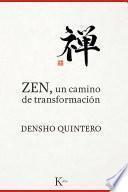
ZEN, un camino de transformación
Autor: Densho Quintero
Número de Páginas: 184Zen, un camino de transformación, reúne los principales escritos del reconocido maestro zen Densho Quintero. Con un estilo muy claro y ameno, Densho nos presenta una visión fresca del zen, desde diferentes ángulos del pensamiento contemporáneo. Nos muestra, por ejemplo, las relaciones entre el budismo zen con las nuevas tendencias de la ciencia moderna, como la neurobiología y la física, al mismo tiempo que reivindica el inapelable origen y carácter budista del zen, del cual ha sido tantas veces desvinculado. Gracias a sus amplios conocimientos de la práctica del zen, el autor nos permite acercarnos a esta práctica milenaria con otros ojos. Con un lenguaje actual, sin perder la perspectiva de la esencia de las enseñanzas tradicionales, nos da señales claras de que podemos transformar las causas de la propia insatisfacción, despertando a nuestra realidad íntima en la práctica del zen.
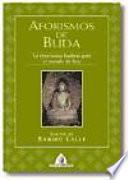
Aforismos de Buda
Autor: Ramiro Calle
Número de Páginas: 140Hoy día, la enseñanza budista, asentada en los pilares de la benevolencia, el cultivo de la mente y la conducta ética, ha suscitado un especial interés en la cultura occidental, ahora más abierta a otras formas de pensamiento religioso ajenas al cristianismo. Este libro tiene el propósito de acercar al lector interesado en el budismo de un modo sencillo, pero a la vez totalmente genuino, a través de las sentencias y enseñanzas del propio Buda. Asimismo, estas profundas sentencias permiten que el libro sea una excelente obra de cabecera para la reflexión y la meditación, además de un modo idóneo de acceder a la más pura doctrina budista.
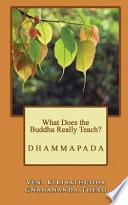
What Does the Buddha Really Teach?
Autor: Kiribathgoda Gnanananda Thero
Número de Páginas: 106Dhammapada- A Collection of Verses Uttered by the Gauthama Buddha found in Pali Canon.

The Dhammapada. New Edition by Suriyagoda Sumangala Thera
Autor: Thera Suriyagoda Sumangala
Número de Páginas: 95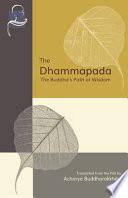
The Dhammapada
Autor: Acharya Buddharakkhita
Número de Páginas: 158An anthology of 423 verses spoken by the Buddha, the Dhammapada serves as the perfect compendium of his teachings for study, reflection, and contemplation. This popular edition from the Buddhist Publication Society transmits the spirit and content as well as the style of the original, skillfully combining clarity and vigor of expression with careful fidelity to the meaning.The inclusion of the Pali text gives students of Pali immediate access to the original. A long introduction by Bhikkhu Bodhi describes the structure of the Dhammapada and shows how the work embodies the essential teachings of the Buddha."Wherever [The Dhammapada] has become known its moral earnestness, realistic understanding of human life, aphoristic wisdom, and stirring message of a way to freedom from suffering has won for it the devotion and veneration of those responsive to the good and the true." from the Introduction
Opciones de Descarga
Últimos libros y escritores buscados
Libros reeditados
- Newyorkinos - Jacqueline Donado
- Congo - David Van Reybrouck
- Sé Ejemplo - Monte Alto Editorial
- Humedades - Casas, Luis Humberto
- Hijos De Sangre Y Hueso (El Legado De Orïsha 1) - Tomi Adeyemi
- Ángel De Sangre - Marisa M. R.
- Anales De La Sociedad Científica Argentina - Sociedad Científica Argentina
- Mistica Y Real Babilonia - Pedro Calderón De La Barca
- La Vida Minimal - Pedro Campos
- Escondida En El Harén - Michelle Conder